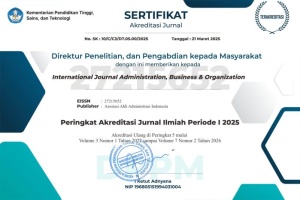Gendered Labor Rights Under Taliban Rule: Addressing Employment Inequality in Post-2021 Afghanistan
Abstract
The Taliban's takeover of Afghanistan on August 15, 2021, marked a pivotal moment in the nation's history and had profound implications for women's labor rights. This policy brief identifies the drastic reduction in women employment as a profound socioeconomic challenge, exacerbated by the de facto authority’s restrictive policies towards women in the workforce. The study uniquely focuses on the intersection of gender and labor rights after regime change, analyzing the growing barriers to women's employment, which not only undermines gender equality but also threatens the broader socioeconomic stability of Afghanistan. This study aims to propose practical policy recommendations that address these inequalities and advocate for international intervention to protect women's labor rights in Afghanistan. Author utilized qualitative analysis, drawing from diverse policy documents and reports, to understand Afghan women's lived experiences under the Taliban regime. Key findings reveal that the Taliban's governance post-2021 has led to significant setbacks in women's employment across various sectors, contributing to economic regression and deepening gender disparities. The brief urges for international financial support to women-led organizations and the promotion of online and home-based employment, alongside relocation programs and rigorous data monitoring for effective policymaking.
References
Afghanistan Crisis update: Women and Girls in Displacement | Factsheet II (2022). UNHCR Operational Data Portal (ODP). https://data.unhcr.org/en/documents/details/95688
Afghanistan Law (2009). Elimination of Violence against Women (EVAW), 1 August, 2009. Islamic Republic of Afghanistan https://www.refworld.org/legal/legislation/natlegbod/2009/en/102513
Agüero, J. M., & Marks, M. (2008). Motherhood and Female Labor Force Participation: Evidence from Infertility Shocks. The American Economic Review, 98(2), 500–504. https://doi.org/10.1257/aer.98.2.500
Ahmed‐Ghosh, H. (2003). A History of Women in Afghanistan: Lessons learned for the future or yesterdays and tomorrow: Women in Afghanistan. Journal of International Women's Studies, 4(3), 1–14. http://iiav.nl/ezines/web/JournalofInternationalWomensStudies/2003/Vol4Nr3May/Afghanistan.pdf
Akbari, F., & True, J. (2022). One year on from the Taliban takeover of Afghanistan: re-instituting gender apartheid. Australian Journal of International Affairs, 76(6), 624-633.
Basiriniya, A., & Ghanizada, S. (2022). Investigating Political, Social, Economic and Cultural Barriers Affecting the Political Presence of Women in Afghanistan Using Structural Equation Modeling. Journal of Subcontinent Researches, 14(42), 93-120.
Baumol, W. and Strom, R. (2007). Entrepreneurship and economic growth. Strategic Entrepreneurship Journal, 1(3-4), pp. 233–237.
Bradshaw, S., Castellino, J., & Diop, B. (2017). Women's role in economic development: Overcoming the constraints. In Did the Millennium Development Goals Work? (pp. 191-216). Policy Press.
Brookings. (2022). Brookings. https://www.brookings.edu/articles/afghanistans-lessons-for-the-sustainable-development-goals-interview-with-naheed-sarabi/
Brunk, I. (2023). Central Bank Immunity, Sanctions, and Sovereign Wealth Funds. Geo. Wash. L. Rev., 91, 1616.
Chaniago, H. (2021). Demographic characteristics and small business success: Evidence from Indonesia. J. Asian Financ. Econ. Bus, 8, 399-409.
Chaniago, H., Muharam, H., & Efawati, Y. (2023). Metode Riset Bisnis dan Permodelan. Bandung: Edukasi Riset Digital, PT.
Chaniago, H., & Efawati, Y. (2024). Individual Innovative Behavior Model: The Role of Entrepreneurial Leadership in Uncertain Times. Quality-Access to Success, 25(202).
Cufadar, A., Dalla, V., & Attahi, M. N. (December, 2023). Two Years In Review: Changes in Afghan Economy, Households, and Cross-Cutting Sectors (August 2021 to August 2023). United Nations Development Program. https://www.undp.org/afghanistan/publications/two-years-review
Duflo, E. (2012). Women empowerment and economic development. Journal of Economic Literature, 50(4), 1051–1079. https://doi.org/10.1257/jel.50.4.1051
Efawati, Y. (2020). The influence of working conditions, workability and leadership on employee performance. International Journal Administration, Business & Organization, 1(3), 8-15. https://doi.org/10.61242/ijabo.20.40
Faria, G. (2022). Women's rights: A year after the Taliban takeover. RadioFreeEurope/RadioLiberty. https://www.rferl.org/a/afghanistan-women-rights-taliban-freedoms/32024050.html
Faridi, M. Z., Chaudhry, I. S., & Anwar, M. A. (2009). The Socioeconomic and Demographic Determinants of Women Work Participation in Pakistan: Evidence from Bahawalpur District. RePEc: Research Papers in Economics. http://pu.edu.pk/images/journal/csas/PDF/12-Mumtaz%20Anwar.pdf
Ferris-Rotman, A. (2013). The long haul. Foreign Policy, (202), 35.
Gaddis, I., & Klasen, S. (2014). Economic development, structural change, and women's labor force participation: A reexamination of the feminization U hypothesis. Journal of Population Economics, 27(3), 639-681. doi. 10.1007/s00148-013-0488-2
Ghufran, N. (2001). The Taliban And The Civil War Entanglement In Afghanistan. Asian Survey, 41(3), 462–487. https://doi.org/10.1525/as.2001.41.3.462
Gibbs, A., Jewkes, R., Karim, F., Marofi, F., & Corboz, J. (2018). Understanding how Afghan women utilize a gender transformative and economic empowerment intervention: a qualitative study. Global public health, 13(11), 1702-1712.
Hakimzai, S. N., & Aa. (2022). Analyzing female labor force participation in Afghanistan: Panel data approach. ResearchGate. https://www.researchgate.net/publication/369708209
Hanifi, M. J. (2012, April 18). Causes and consequences of the destabilization of Afghanistan. Middle East Institute. Retrieved April 18, 2012, from https://www.mei.edu/publications/causes-and-consequences-destabilization-afghanistan
Hashim, I. (1999). Reconciling Islam and Feminism. Gender and Development. 7 (1): 7-14.
Janin, H., & Kahlmeyer, A. (2007). Islamic Law: The Sharia from Muhammad's Time to the Present. http://ci.nii.ac.jp/ncid/BA90819797
Kaci, Y. A. (2015). Universal Declaration of Human Rights . United Nations. https://digitallibrary.un.org/record/815442/files/human-rights-booklet.pdf
Laub, Z. (2017, May 1). The US war in Afghanistan. Council on Foreign Relations. https://www.cfr.org/timeline/us-war-afghanistan
Mannell, J., Grewal, G., Ahmad, L., & Ahmad, A. (2021). A qualitative study of women's lived experiences of conflict and domestic violence in Afghanistan. Violence against women, 27(11), 1862-1878.
Masih, Z. (2021). Female Labour Force Participation In Afghanistan: Changes, Economic Activities and Determinants. https://doi.org/10.13140/RG.2.2.18193.40802
Mendonca, S. P. (2021, August 17). 10 rules women had to follow under the Taliban regime in Afghanistan in 1996. International Business Times, Singapore Edition. https://www.ibtimes.sg/10-rules-women-had-follow-under-taliban-regime-afghanistan-1996-59671
Mincer, J. (1962). Labor Force participation of Married Women: A study of Labor Supply. https://econpapers.repec.org/bookchap/nbrnberch/0603.htm
Ministry of Foreign Affairs. (2015). Afghanistan’s NAP on Women, Peace, and Security Ministry of Foreign Affairs, Directorate of Human Rights and Women’s International Affairs. https://unama.unmissions.org/sites/default/files/wps-afghanistan_national_action_plan_1325_0.pdf
Mohammadinia, M. Z. (2021). Female Labour Force Participation In Afghanistan: Changes, Economic Activities And Determinants (Doctoral dissertation, South Asian University).
Monthly forecast December. (2023). Security Council Report. (n.d.). https://www.securitycouncilreport.org/monthly_forecast/2023-12
Myatt, T. M. (2015). A qualitative study of successful women entrepreneurs: developing a model for war-torn Afghanistan. Fielding Graduate University.
Nehan, N. (2022). The rise and fall of women's rights in Afghanistan. LSE Public Policy Review, 2(3). https://doi.org/10.31389/lseppr.59
North, D. (1990). Institutions, Institutional Change and Economic Performance. New York NY: Cambridge University Press.
Nuraini, A., Chaniago, H., & Efawati, Y. (2024). Digital Behavior and Impact on Employee Performance: Evidence from Indonesia. Journal of Technology Management & Innovation, 19(3), 15-27.
Safi, L. (2024). Review of Afghanistan's development pattern from 2001 to 2021: a relative lack of sustainability, inclusiveness, and prosperity. Journal of Social and Economic Development, 26(1), 333-352.
Scott, W. (2007). Institutions and organizations: Ideas and interests. Thousand Oaks, CA: Sage.
Smallbone, D. and Welter, F. (2012). Entrepreneurship and institutional change in transition economies: The Commonwealth of Independent States, Central and Eastern Europe and China compared. Entrepreneurship & Regional Development, 24(3-4), pp. 215-233.
Taasim, S., & Daud, A. (2020). The Effect of Gender Unemployment on Economic Growth: A Panel Data Analysis. Journal of Business and Economics Review, 5, 94-103. https://doi.org/10.35609/jber.2020.5.3(3)
Taylor, A. M. (2022). The Relationship Between Women's Education, Women's Employment, Gender Development, and Gender Inequality: A Case Study of Afghanistan, 2000-2019 (master's thesis).
The Sustainable Development Goals Report. (2023). In The Sustainable Development Goals report. Special Edition. https://doi.org/10.18356/9789210024914
UN Women. (2007). National action plan for the women of Afghanistan (2007-2017). Islamic Republic of Afghanistan.
UN Women. (2021). Women's rights in Afghanistan one year after the Taliban takeover. UN Women – Headquarters. https://www.unwomen.org/en/digital-library/publications/2022/08/gender-alert-no-2-womens-rights-in-afghanistan-one-year-after-the-taliban-take-over
UN Women. (2022). Promoting The Recruitment And Retention Of Women Humanitarian Workers In Afghanistan; https://asiapacific.unwomen.org/sites/default/files/2022-10/af-Women-Humanitarian-Workers-Study.pdf
UN Women. (2023). Afghan Women's Voices – Summary report of countrywide women's consultations. Asia-Pacific. https://asiapacific.unwomen.org/en/digital-library/publications/2023/03/afghan-women-voices
UN. (2022). United Nations and top aid officials slam Afghan rulers' NGO ban for women. UN News. https://news.un.org/en/story/2022/12/1132082
UN. (2023). United Nations. https://www.ohchr.org/en/press-releases/2023/03/afghanistan-un-experts-say-20-years-progress-women-and-girls-rights-erased
United Nations Statistics Division. (2023). Progress Chart — SDG Indicators. https://unstats.un.org/sdgs/report/2023/progress-chart/
Uygun, H., & Gujrati, R. (2022). Protect Labour Rights and Promote Safe Working environment. Journal of Pedagogical Inventions and Practices, 8, 9-15.
Welter, F., & Smallbone, D. (2011). Institutional perspectives on entrepreneurial behavior in challenging environments. Journal of small business management, 49 (1), 107-125.
World Bank Group (2023), "Women, Business and the Law." URL https://wbl.worldbank. org/en/wbl.
World Bank. (2014). Women's role in Afghanistan's future - taking stock of achievements and continued challenges. https://documents.worldbank.org/en/publication/documents-reports/documentdetail/813391468184173017/womens-role-in-afghanistans-future-taking-stock-of-achievements-and-continued-challenges
World Bank. (2021, April 5). Afghanistan Development update, April 2021: Setting course to recovery. World Bank Group. http://hdl.handle.net/10986/35363
Zhou, J., Ghiasy, R., & Hallgren, H. (2015). Afghanistan's Private Sector: Nexus with Security, Status, and Ways Forward. ResearchGate. https://www.researchgate.net/publication/313359342_Afghanistan%27s_Private_Sector_Nexus_with_Security_Status_and_Ways_Forward
Copyright (c) 2024 Adila Haidari

This work is licensed under a Creative Commons Attribution-ShareAlike 4.0 International License.
Authors who publish in this journal agree to the following terms:
- The authors confirm that they are the authors of the submitted article, which will be published (online) in the journal IJABO (International Journal Administration, Business & Organization) by the Asosiasi Ahli Administrasi Indonesia (A3i), Bandung, Indonesia. The author’s name will be evident in the article. The publisher makes all decisions regarding the layout and distribution of the work.
- Authors guarantee that the work is their own original creation and does not infringe any statutory or common-law copyright or any proprietary right of any third party. In case of claims by third parties, authors commit themself to defend the interests of the publisher and shall cover any potential costs.
- Authors retain copyright and grant the journal the right of first publication, with the work simultaneously licensed under a Creative Commons Attribution-ShareAlike 4.0 International License (CC BY-SA 4.0). This license allows the redistribution and reuse of papers provided the authorship is properly credited.
- Authors can enter into separate, additional contractual arrangements for the non-exclusive distribution of the journal's published version of the work (e.g., posting it to an institutional repository or publishing it in a book), with an acknowledgment of its initial publication in this journal.
- Authors are permitted and encouraged to post their work online (e.g., in institutional repositories or on their website) prior to and during the submission process, as this can lead to productive exchanges and earlier and greater citations of published work.

















